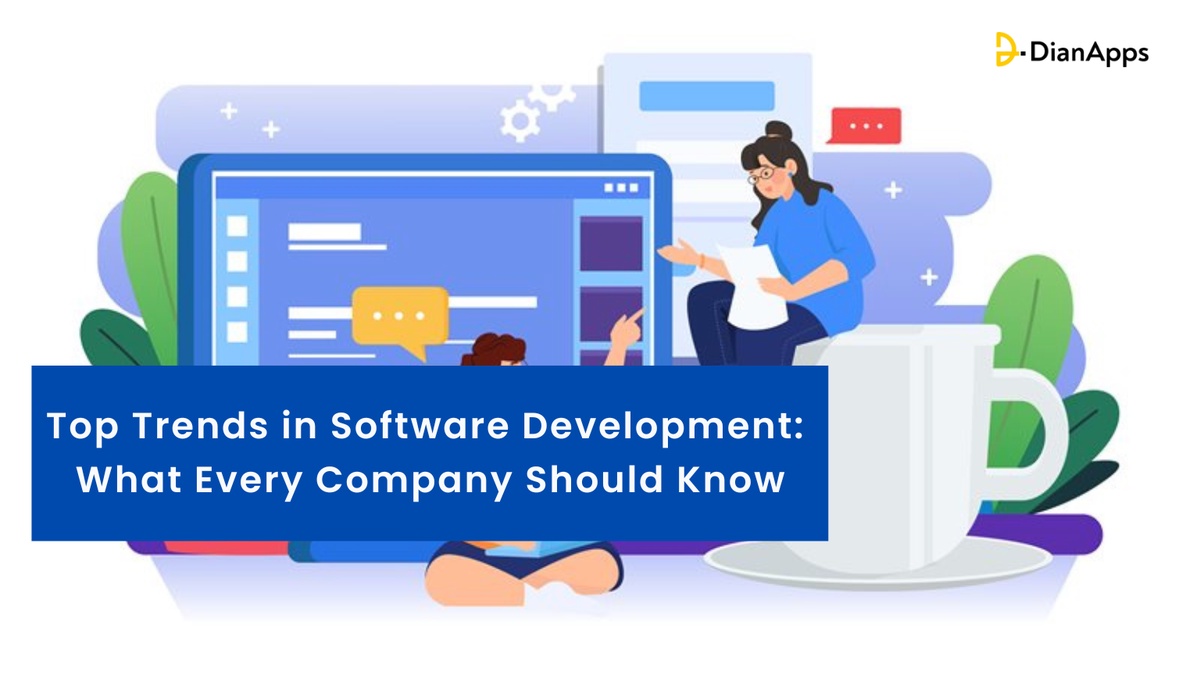In today's rapidly evolving technological landscape, software app development trends play a crucial role in shaping the success and competitiveness of businesses. Staying updated with the latest trends is vital for companies seeking to streamline their development processes, enhance user experiences, and gain a competitive edge in the market.
In this post, we will explore the top trends in software development that every company should be aware of. By embracing these trends, organizations can drive innovation, improve efficiency, and deliver high-quality software solutions to meet the ever-changing needs of their customers.
Let’s start with the software development statistics.
Top Software Development Statistics Every Company Must Know
Global Software Development Market Size:
-
- The global software development market was valued at USD 456.44 billion in 2020.
- It is projected to reach USD 673.83 billion by 2026, with a CAGR of 6.2% during the forecast period (2021-2026).
Programming Languages:
-
- As of 2021, the most popular programming languages are JavaScript, Python, Java, C/C++, and C#.
- JavaScript continues to dominate the programming language landscape, with a high adoption rate due to its versatility in website development.
Agile Methodology Adoption:
-
- Agile methodologies are widely adopted in software development, with 71% of organizations reporting using Agile approaches in their projects.
- Scrum is the most popular Agile framework, followed by Kanban and Lean.
DevOps Adoption:
-
- DevOps adoption is on the rise, with 86% of organizations implementing DevOps practices in their software development processes.
- DevOps adoption leads to improved software quality, faster time-to-market, and increased collaboration between development and operations teams.
Cloud Adoption:
-
- Cloud computing has become the standard for software development, with 94% of organizations using at least one cloud service.
- Amazon Web Services (AWS), Microsoft Azure, and Google Cloud Platform (GCP) are the top cloud providers.
Mobile App Development:
-
- The mobile app market is thriving, with approximately 218 billion mobile app downloads in 2020.
- Android and iOS app development are the dominant platforms for mobile app development, with Google Play Store and Apple App Store being the primary distribution channels.
Open Source Software (OSS):
-
- Open-source software plays a crucial role in software development, with approximately 80% of businesses using OSS components in their applications.
- Popular open-source frameworks and tools include Node.js, React, Angular, Django, and TensorFlow.
Software Security:
-
- Security is a major concern in software development, with 43% of mobile app developers considering it the most challenging aspect of their work.
- Approximately 30% of developers report encountering a security breach in their applications.
These statistics provide a glimpse into the software development landscape, highlighting the adoption of various methodologies, technologies, and industry trends. It's important to note that these numbers may vary based on industry, region, and specific business requirements.
Striving Trends of Software Development for Businesses
1. Artificial Intelligence and Machine Learning
Artificial Intelligence (AI) and Machine Learning (ML) have transformed the software development landscape, opening up a world of possibilities. AI-driven technologies such as natural language processing, computer vision, and predictive analytics are revolutionizing industries across the board.
Top website development company like DianApps, are leveraging AI and ML to automate processes, make data-driven decisions, and provide personalized user experiences. Intelligent chatbots, virtual assistants, and recommendation systems are just a few examples of how the impact of AI is changing the world around software applications. By embracing AI and ML, businesses can gain valuable insights, optimize operations, and enhance customer engagement.
2. Low-Code and No-Code Development
The rise of low-code and no-code development platforms has democratized software development, allowing professionals with limited coding skills to build applications. These platforms provide visual interfaces, pre-built components, and drag-and-drop functionalities, reducing the reliance on manual coding. Low-code and no-code development accelerate the software development life cycle, enabling rapid prototyping and faster time-to-market.
Additionally, these platforms empower business users to create their own applications, reducing the burden on IT departments and fostering innovation within organizations. By adopting low-code and no-code development, companies can streamline their development processes, boost productivity, and bridge the gap between business requirements and software development services.
3. Cloud-Native Development
Cloud-native development has gained significant traction in recent years, thanks to the scalability, flexibility, and cost-efficiency it offers. By designing applications specifically for cloud environments, companies can fully leverage the benefits of cloud computing.
Cloud-native development emphasizes containerization, microservices architecture, and continuous integration and deployment (CI/CD). These approaches enable web developers to build, deploy, and scale applications more efficiently. With cloud-native development, businesses can achieve greater agility, reduce infrastructure costs, and improve the overall reliability and resilience of their software systems.
4. Internet of Things (IoT) and Edge Computing
The Internet of Things (IoT) continues to expand its reach, connecting an ever-growing number of devices and generating massive amounts of data. Software development for IoT involves building applications that interact with these connected devices and effectively process the generated data. Edge computing has emerged as a crucial component of IoT development, allowing data processing to occur closer to the source, reducing latency, and improving real-time decision-making. Companies are leveraging IoT and edge computing to drive innovation in various domains, including smart homes, healthcare, manufacturing, and logistics.
By integrating IoT and edge computing into their software development strategies, businesses can unlock new opportunities, optimize operations, and deliver personalized and context-aware experiences to their users.
Also Read IoT, bots, and mobile apps- A victorious trident for the future.
5. DevOps and Agile Development
DevOps and Agile methodologies have become the de facto standard for modern software development. These approaches emphasize collaboration, iterative development, and continuous integration and delivery. DevOps developers encourage close collaboration between development and operations teams, streamlining the software development life cycle and promoting faster and more reliable software releases.
Agile development, on the other hand, focuses on iterative and incremental development, allowing businesses to respond quickly to changing requirements. By adopting DevOps and Agile methodologies, organizations can improve communication, increase efficiency, and achieve faster time-to-market while maintaining high-quality software products.
6. Cybersecurity and Privacy
With the increasing reliance on digital technologies, cybersecurity, and privacy have become paramount concerns for businesses and users alike. Software app development companies are now focusing on building secure and resilient applications that protect sensitive data and mitigate the risk of cyber threats.
This involves implementing robust encryption techniques, adopting secure coding practices, conducting regular vulnerability assessments, and ensuring compliance with data protection regulations such as GDPR and CCPA. By prioritizing cybersecurity and privacy in software development, companies can establish trust with their users, safeguard their reputations, and avoid costly data breaches.
7. Progressive Web Applications (PWAs)
Progressive Web Applications (PWAs) are web-based applications that offer a native-like experience to users across various devices and platforms. PWAs are a need for hour tool because it combines the best features of web and mobile app development, enabling offline access, push notifications, and seamless performance.
They are built using web technologies like HTML, CSS, and JavaScript but provide a more app-like experience. PWAs eliminate the need for users to download and install traditional mobile apps while offering the benefits of cross-platform compatibility and easy updates. By adopting PWAs, companies can reach a wider audience, improve user engagement, and reduce development and maintenance costs associated with developing separate native apps for different platforms.
8. Blockchain Technology
Blockchain technology, initially popularized by cryptocurrencies like Bitcoin, has expanded its potential beyond the financial sector. Blockchain technology solutions offer a decentralized and transparent ledger system that ensures immutability, security, and trust in transactions and data exchange.
Software developers are exploring the integration of blockchain into various applications, including supply chain management, healthcare records, voting systems, and intellectual property rights management. By leveraging blockchain technology, companies can enhance data integrity, streamline processes, eliminate intermediaries, and enable secure peer-to-peer interactions.
However, it's important to carefully evaluate the use cases and potential limitations of blockchain for each specific application, as it may not be suitable for every scenario.
By staying abreast of these additional trends in software development, companies can proactively adapt their strategies to meet the evolving needs and expectations of their users while gaining a competitive advantage in the market.
Conclusion
To thrive in the ever-changing landscape of custom software development, companies must keep a close eye on emerging trends and technologies. Artificial Intelligence and Machine Learning, low-code and no-code development, cloud-native development, Internet of Things and edge computing, and DevOps and Agile methodologies are just a few of the top trends that every company should be aware of.
By embracing these trends, organizations can drive innovation, enhance customer experiences, and gain a competitive edge. However, it's important to note that each company's software development strategy should be tailored to its unique needs and objectives.
Hiring reliable web app developers from DianApps can help in staying informed, and adapting to the latest trends, businesses can position themselves for success in the dynamic world of software development.
Article Source: https://medium.com/@marketing_96275/top-trends-in-software-development-what-every-company-should-know-8ef2b3e9c0a5


No comments yet